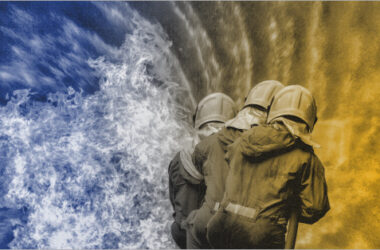When a business suffers accidental loss or damage due to fire, the costs can be astronomical. Not only is there the cost of repairs or replacement of the damaged insured property, but there is also the potential for lost revenue if the business has to shut down for an extended period. Fire Insurance can help cover these costs and get the business up and running as quickly as possible. This blog will look into the intricacies of Fire Insurance, explaining its coverage, types and how it can safeguard your valuable assets.
Fire Insurance: A Brief Overview
A Fire Insurance Policy is essentially a contract that ensures financial protection to the policyholder against loss or damage caused by fire-related incidents. It covers the insured property, which could include residential, commercial or industrial buildings and the contents within, such as machinery, stock or furniture. The Fire Insurance Policy compensates for the destruction or damage resulting from events like accidental fire, lightning, explosions or other fire-related perils specified in the policy. This property insurance may also extend coverage to ancillary loss or damage caused by smoke, water or firefighting efforts. In India, this type of property insurance is essential for safeguarding assets and ensuring business continuity, particularly for organisations operating in risk-prone sectors.
Types of Fire Insurance Policies
Different types of Fire Insurance policies are designed to cater to the unique needs of businesses. Some of them are discussed below:
Standard Fire and Allied Perils Policy
Under the Standard Fire and Allied Perils Policy (SFSP), the following hazards are covered:
- Fire
- Lightning
- Implosion/Explosion
- Damage to aircraft
- Strike, riot and malicious damage
- Storms, typhoons, cyclones, tempests, tornadoes, floods, hurricanes and inundations
- Impact damage
- Landslide and subsidence
- Tanks, apparatus and pipes bursting or overflowing
- Automatic sprinkler installation leakage
- Fire spreading out of nearby vegetation
Additional Fire Insurance covers can be included in the SFSP policy by endorsement and by paying additional premiums.
Special Fire Insurance Policies
- Floater Policy
This Fire Insurance Policy is issued for stocks stored in warehouses or godowns at various locations but belonging to the policyholder. It is ideal for businesses where stock is frequently moved between godowns and tracking individual movements is impractical. This policy allows for one sum insured to cover stock across multiple locations.
- Declaration Policy
This type of Fire Insurance Policy is beneficial for businesses where stock values fluctuate frequently. Instead of insuring a lower fixed amount (which may lead to underinsurance), businesses declare stock values periodically (e.g., monthly) and the premium is calculated based on the average stock values at the end of the policy year. Excess premiums, if any, are refunded to the policyholder.
- Floater Declaration Policy
This policy combines the benefits of a Floater Policy and a Declaration Policy, covering stocks at multiple locations with fluctuating values while adjusting premiums based on declared stock values.
The Concept of Insurable Interest in Fire Insurance
Insurable interest is a crucial principle in Fire Insurance, ensuring that the policyholder has a genuine financial stake in the insured property. This means that individuals purchasing Fire Insurance must suffer a financial loss if the insured asset is damaged by fire. Without this monetary interest, an insurance contract is considered speculative and is unenforceable.
Legally, this principle prevents insurance from being used as a speculative investment. Morally, it ensures that insurance serves as a means of protection against financial loss rather than an opportunity for profit.
Assets Covered by Fire Insurance
Fire Insurance typically provides coverage for assets damaged or destroyed by fire, including:
- Buildings: Covers the cost of repairing or rebuilding premises damaged or destroyed by fire, including structures, fixtures and fittings.
- Stock: Covers the value of inventory, goods or merchandise, including raw materials, finished products and work in progress.
- Contents: Covers the cost of replacing or repairing personal property such as furniture, electronics and other belongings.
12 Perils of Fire Insurance
Fire Insurance typically covers the following 12 perils:
- Fire: Damage caused by flames resulting from combustion.
- Lightning: Damage caused by lightning strikes leading to fire.
- Explosion/Implosion: Damage caused by explosions, whether internal or external.
- Riot and Civil Commotion: Damage caused by riots, civil unrest or public disturbances.
- Malicious Damage: Damage intentionally caused by individuals with ill intent.
- Aircraft Damage: Damage caused by aircraft or objects falling from them.
- Impact Damage: Damage caused by vehicles or objects colliding with the insured property.
- Subsidence and Landslide: Damage resulting from ground movement, including subsidence and landslides.
- Bursting or Overflowing of Water Tanks, Apparatus and Pipes: Damage caused by water leakage.
- Storm, Cyclone, Typhoon, Tempest, Hurricane, Tornado, Flood and Inundation: Damage caused by severe weather events.
- Earthquake: Damage caused by seismic activity, including tremors and earthquakes.
- Bush Fire: Covered only if specifically included in the policy.
What is Not Covered Under Fire Insurance?
Typical exclusions in Fire Insurance policies include:
- Wilful or deliberate acts
- Cold storage stock losses due to temperature changes
- Damage due to war, nuclear perils or contamination
- Missing property
- Earthquake or volcanic eruption (unless covered with an additional premium)
- Indirect losses
- Claims preparation costs
- Unoccupied premises beyond a stipulated period
- High-value items like bullion, stones or artwork (unless specifically insured)
- Electrical short circuits (only affecting the appliance, unless leading to fire)
- Acts of terrorism (unless covered separately)
- Spoilage losses due to process interruption
- Theft during or after a fire (except under specific covers)
Add-On Covers in Fire Insurance Policies
Fire Insurance policies may include additional covers to address specific risks:
- Earthquake (Fire and Shock): Covers damages caused by earthquakes.
- Forest Fire: Covers damages caused by wildfires.
- Impact Damage Due to Insured’s Own Vehicle: Covers damage caused by forklifts or other machinery within insured premises.
- Deterioration of Stocks in Cold Storage: Covers losses due to accidental power failure or temperature changes.
- Architects’ Fees: Covers professional fees for reconstruction or repair.
- Debris Removal: Covers debris removal costs exceeding a certain percentage of the claim.
- Omission to Insure Clause: Covers additions or extensions made to the insured property during the policy period.
- Loss of Rent Clause: Covers loss of rental income due to fire damage.
- Start-Up Expenses: Covers costs incurred in restarting business operations after a fire loss.
Deductibles and Limits in Fire Insurance Policies
Fire Insurance policies in India include deductibles (the portion of the loss the policyholder must bear) and limits (the maximum amount payable by the insurer). Deductibles help minimise minor claims and encourage loss prevention, while limits cap the insurer’s liability. Fire Insurance policies may be structured based on Reinstatement Value (replacement cost) or Market Value (depreciated cost).
Final Thoughts
Fire Insurance remains one of the most essential coverages for businesses. As a business owner, ensuring adequate coverage against fire-related risks can help mitigate financial losses and ensure business continuity. Understanding Fire Insurance coverage, exclusions and available add-ons is key to making an informed decision and securing your business against unforeseen disasters.








